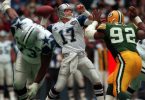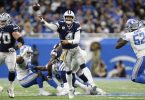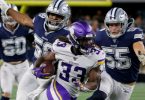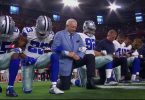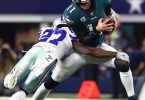He was guaranteed not to play a down in the NFL for at least four years.
He was committed – body, mind, heart and soul – to the United States Air Force.
He routinely piloted dangerous missions into active battlefields.
But considering the Cowboys’ lousy lineage of acquiring – um, let’s go with “troubled” – defensive linemen, Chad Hennings was a surprisingly safe bet.
“Going straight from the war to football was the biggest challenge I’ve ever faced,” Hennings said last week during a podcast rehearsal in Dallas. “There are obviously traits that carried over, but it was just a whole new world. Physically. Emotionally. Mentally. Spiritually. I went from taking out the enemy to learning how to be teammates with Charles Haley and Michael Irvin.”
Long before owner/GM Jerry Jones repeatedly whiffed with defensive linemen from Alonzo Spellman to Dimitrius Underwood to Josh Brent to Greg Hardy to David Irving to Randy Gregory and now Robert Quinn, newly minted Pro Football Hall of Famer Gil Brandt got it exactly right for the Cowboys, nailing a low-risk, high-reward gamble.
In 1987, Hennings won The Outland Trophy as college football’s best lineman. In 1988, Dallas drafted him … in the 11th round.
“I’m not saying he’s Roger Staubach,” Brandt said at the time about another wait-and-see draft choice that turned out pretty decent. “But we know first-hand that the character it takes in the military can translate to the football field. Chad has all the physical and mental tools to dominate in the NFL. We think he’s worth the risk. Hopefully someday it pays off.”
Hennings had it all, by not having anything.
No bipolar disorder. No anger mismanagement. No substance abuse. No domestic violence. No arrests. No fatal DWI car crashes. No performance-enhancing drugs.
I bumped into Hennings last week, the same day it was announced that Quinn was suspended two games by the NFL for violating its ban on performance-enhancing drugs. Quinn, remember, was signed as a free agent insurance policy in case the Cowboys don’t get back Gregory, currently serving his fourth suspension for substance abuse. Oh, and Gregory’s speed on the edge was supposed to be the perfect bookend to DeMarcus Lawrence, who has blossomed into an elite pass rusher but in 2016 himself was suspended four games for using amphetamines.
On it goes. So consistently crappy, in fact, that Quinn and Gregory starting 2019 out of uniform continues the Cowboys’ sheepish streak. Make it six consecutive seasons they’ve kicked off with at least one defensive player serving an NFL suspension.
“I don’t want to comment too much on that,” head coach Jason Garrett said during training camp in Oxnard last week. “There’s specific circumstances involved with each guy that are different from the others. Obviously it’s not something we want for our football team.”
This is not to suggest that Jones has whiffed on every defensive lineman. Russell Maryland was a solid No. 1 overall pick. Despite arriving with a sketchy reputation, Tony Casillas contributed to a deep rotation that won three Super Bowls. Ditto for Charles Haley. And, despite his infamous gaffes in the snow and the Super Bowl, Leon Lett was a two-time Pro Bowl steal as a seventh-rounder.
This is also not to suggest that there isn’t something inherently savage, simplistic and, yes, screwy about the position. Sure, there are varying techniques and tricks, but defensive linemen are all about eradicating the blocker in front of you and hunting the football. It’s spawned legendarily intimidating players such as “Mean” Joe Greene, Ndamukong Suh, Warren Sapp, Deacon Jones and Jack Youngblood, who played in Super Bowl 14 with a broken leg. Defensive lines have inspired nicknames like the “Fearsome Foursome,” “Steel Curtain,” “Purple People Eaters” and, of course, “Doomsday.”
Worth the weight and void of baggage, Hennings finally arrived at Valley Ranch as a 27-year-old rookie with superior athleticism, unprecedented character and not a single screw loose.
“Every father wants their son to grow up to be Chad Hennings,” Troy Aikman once told me. “The guy’s straight outta Hollywood.”
Before he won three rings with “America’s Team,” he fought for America’s real team. Fulfilling an eight-year military commitment with the Air Force, Hennings was stationed in England and piloting the A-10 “Warthog,” an aircraft designed to destroy tanks from three miles away via a machine gun that deployed 4,000 bullets per minute. He wound up flying 45 missions into Iraq, some to combat Saddam Hussein’s Republican Guard and others to escort C-130 aircraft that dropped supplies – tents, blankets, food – to refugees in the mountains fleeing the threat of deadly mustard gas dropped by their former dictator.
“I chose the Air Force because I wanted a unique experience,” Hennings said. “Wanted to challenge myself at a higher level as far as integrity and character. But a part of me also always wanted to play football.”
Though drafted by the former brain trust of Brandt, Tex Schramm and Tom Landry, Hennings became a Cowboy in 1992 only after a tryout for Jones and Jimmy Johnson.
Said defensive coordinator Butch Davis after watching Hennings’ post-layoff workout, “We just had a No. 1 draft pick fall in our lap.”
He was 6-foot-6 and 290 pounds of discipline and deltoids. But the transition almost killed him. From the cool climate of England to the 100-degree heat and humidity of training camp at St. Edward’s in Austin, Hennings struggled to assimilate.
“I was losing 12-14 pounds of water weight during the morning workout,” he remembers. “Then trying to replenish before doing it again in the afternoon. And that was in addition to competing against the best offensive line in football with guys like Mark Tuinei, Nate Newton and Mark Stepnoski.”
Between the IVs, Johnson’s barking, unrealistic expectations and the spartan existence of St. Ed’s cinder-block dorms, Hennings grew frustrated and unconfident.
“I was like, ‘What the heck did I just do?’,” he said.
He was never fast enough to be Haley or Harvey Martin, or agile enough to be Randy White or Bob Lilly, but Hennings adapted well enough to be a front-line contributor on Dallas’ three Super Bowls champions in the ’90s. In nine years, he started 72 games, produced 24 sacks and won enough jewelry to adorn his hands for a lifetime.
Since retirement in 2000, Hennings has raised two children now out of college, written three books about leadership, developed into a motivational speaker and launched a successful – surprise! – career in DFW commercial real estate.
“Business was always the wild card for me,” he said. “I knew being in the military or the NFL was what I did, but I didn’t want it to be who I was.”
Considering their various forays along the personality spectrum of recent defensive linemen, the current Cowboys could use a little Chad Hennings.


